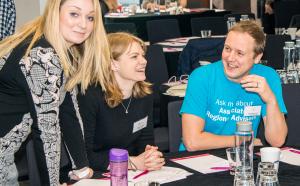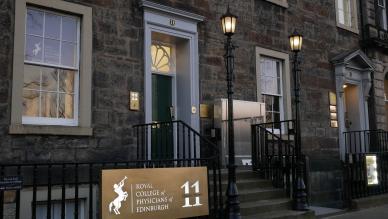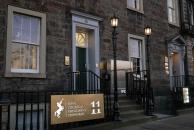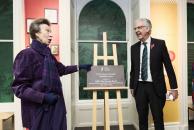

HOOKED: New exhibition on 500 years of addiction
21 May 2025
HOOKED: New exhibition on 500 years of addiction
The Royal College of Physicians of Edinburgh (“the College”) is next week launching a new exhibition which uncovers the history of addiction- from heroin to gambling, from alcohol to love- and invites the public to consider the stereotypes attached to addiction and how all of us can be vulnerable to it. HOOKED features photographs from Leith-born artist Graham MacIndoe’s Coming Clean series which document his addiction to both heroin and crack cocaine.
The exhibition also features a first edition of a rare French text, Erotomania (1640) which details the diagnosis and treatment of addiction to love. It includes interviews with high profile addiction specialists and experts on Scotland’s drugs deaths crisis, including Dr Saket Priyadarshi (Associate Medical Director of Greater Glasgow and Clyde Alcohol and Drug Services), Prof Catriona Matheson (Professor in Substance Use at the University of Stirling) and Prof Roy Robertson (Professor of Addiction Medicine at the University of Edinburgh).
Exploring pills, drink, snuff and cigarettes, HOOKED uncovers the many faces of addiction and the many attempts to combat it. It explores the dark origins of substance addiction in the western world – rooted deeply in colonialism and slavery. The exhibition features rare books, historical objects, artworks, interviews and digital interactives, and it considers the meaning of addiction, its causes and the stigma attached to being “addicted”.
Contributing artist Graham MacIndoe said:
The photographs in this series were taken over almost a decade when I was addicted to heroin and crack. I’d been working as a photographer in New York and some upheaval in my personal life mixed with bad choices sent me on a downward spiral that started with drinking and eventually led to drugs. For much of that time, I managed to maintain my career and was in denial about having a problem. Then one day I caught my reflection in a bathroom mirror and what I saw scared me. My skin was grey, my eyes were dead, and I looked like I hadn’t slept for ages. I took a picture of myself with my mobile phone, and that’s how I started documenting my addiction.
I didn’t think I’d ever do anything with the photos, but I felt compelled to record what was happening to me. I’d prop a cheap digital camera on a shelf or the floor and set the self-timer to take pictures as I went about the rituals of my habit. The rough, grainy quality of the images reflects the environment I was living in — a housing project in Brooklyn. About a year after I got clean, I came across hundreds of images from that period saved on old USB thumb drives. Looking at them at first was tough, and I wasn’t sure if I’d ever show them. But I decided I wanted people to see what addiction looks like from the inside — through the eyes of someone who lived through it.
Dr Daisy Cunynghame (curator of ‘HOOKED: 500 years of addiction’) said:
Our society is filled with addiction. From our morning coffee to our afternoon chocolate bar. How we think about addictive substances – about coffee, about alcohol, about opiates – is often not based on science. In this exhibition we wanted to explore all the different biases, stigma and the baggage that comes along with how we think about addiction. Why was opium viewed as safe to give to children, whilst horror stories were written about the risks of coffee drinking? Why was beer seen as more dangerous to drink than wine? Historically we’ve really struggled to get away from social class, race and gender stereotypes when we think about addiction.
Notes to Editors:
Content information:
- As well as objects, illustrations and manuscripts the exhibition has two touchscreens – one exploring the topic of gambling and the other showing short interviews with modern-day practitioners and recovering addicts
- The exhibition looks at the history of addiction in Western culture
- It does this through four themes: defining addiction, the causes of addiction, addiction stigma and attempts to combat addiction
- Objects are a large part of the exhibition, and two of the most interesting items are: a Victorian Yorkshire miner’s tobacco tin and a Vicodin-branded bumbag – an example of a US pharmaceutical representative’s promotional material during the 1990s opioid epidemic
Some interesting points:
- Through objects and books the exhibition explores the role of colonialism and slavery in the origins of many addictive substances, including tobacco, coffee, tea and opium.
- The exhibition explores changing understanding of addiction – including examples of opium-based medicines prescribed to children and 1600s books warning against the addictive dangers of tea drinking.
- The exhibition includes a 1920s bottle of Jamaica Ginger – a highly alcoholic medicine which was prescribed in the US during the prohibition era. Toxic ingredients caused a type of paralysis known as Jake Paralysis. This inspired many blues songs, including Jake Walk Blues, Jake Walk Papa and Jake Liquor Blues.
- The exhibition uses satirical and moralising caricatures like Chirurgico-Comico (1838) and The Tree of Intemperance (mid 1800s) to explore the stigma and censure which addicted people faced.
- The exhibition will run from 30 May 2025 to 13 February 2026
- The exhibition is free
- Open Monday – Friday 10am – 4.30pm but with some evening and weekend openings (see website for more information)
- A full public programme of events will accompany the exhibition, more information can be found on the exhibition webpages
- The web address is www.rcpe.ac.uk/hooked







